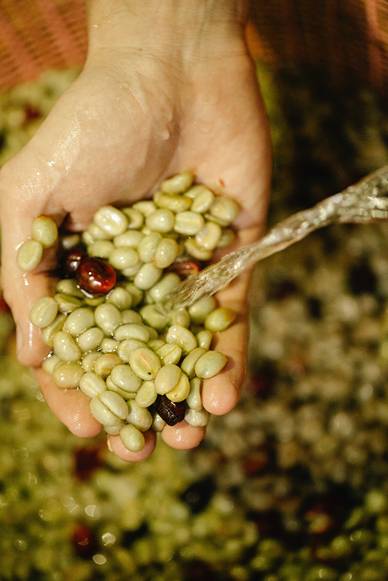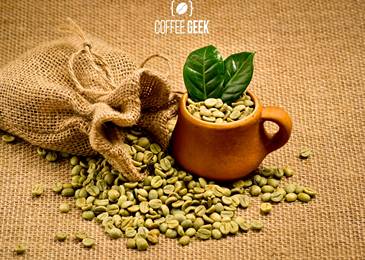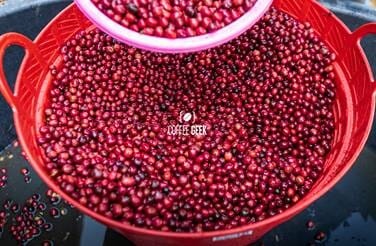Coffee is one of the most popular beverages in the world, but many people don’t know about anaerobic coffee and its unique benefits.
Most coffee enthusiasts are unaware there’s a special type of coffee made through anaerobic fermentation that can provide more flavor complexity and benefits than traditional brews or espresso coffees.
In this article, I’ll show you the ins and outs of anaerobic coffee – what makes it unique, how to make it yourself, and answer some FAQs.
So pour yourself that cuppa, and let’s start uncovering the tastiness in your next mugful.
Why Is Coffee Anaerobic?
Anaerobic coffee is made through anaerobic fermentation.
This processing method occurs when the coffee cherries are soaked in water and sealed away from oxygen for several days or weeks, allowing beneficial microorganisms to populate and break down the coffee’s proteins and carbohydrates into compounds that produce unique flavor notes.
Because this fermentation process happens without oxygen, it’s called anaerobic. In comparison, the more commonly known method of preparing coffee – roasting and grinding beans – occurs in an aerobic environment.
Anaerobic processing is becoming increasingly popular in the specialty coffee world.
Not only does the method create an incredible range of flavor complexity, but it offers other health benefits too. Let’s take a closer look at both aspects.
Anaerobic Coffee Taste – Flavors
The flavor profile of anaerobic coffee is complex, vibrant, and refreshing.
Its unique taste can range from sweet and fruity to tangy and earthy depending on the additives used in the fermentation process, such as fruits or honey.
This intense range of flavors is because anaerobic fermentation helps break down the proteins and carbohydrates in the coffee beans more fully, creating compounds that can mix with the natural flavor of the coffee bean to produce a far fruitier taste than you would normally get from coffee.
Anaerobic Coffee Texture

As well as having a unique taste, anaerobic coffee has a distinct texture.
It tends to be creamier and smoother than regular coffee while retaining some slight bitterness that makes it so enjoyable.
I like to think of anaerobic coffee as a mellowed-out version of regular coffee – it’s still unmistakably a cup of coffee but without the harshness that can make espresso or filter coffee too strong for some people.
How Do You Make Anaerobic Coffee?
To make anaerobic coffee, you will need the following:
- Green coffee beans
- A sealable container (such as a mason jar or vacuum sealer)
- Additives such as honey, fruits, or spices (optional)
Here is the step-by-step process for making anaerobic coffee:
- Begin by cleaning and prepping your coffee beans. Before the process, remove any debris or foreign matter from the beans.
- Pulp the coffee cherries to remove the outer layer of skin and reveal the coffee beans inside.
- Place your coffee beans into a sealable container.
- Squash the mucilage (the sticky membrane around the coffee beans) and add any additional additives.
- Seal the container tightly and store it at room temperature (70-75 degrees Fahrenheit) for fermentation.
- Observe the coffee regularly to ensure the flavor develops as desired. If the taste does not meet your expectations, balance it with more additives.
- Once the desired flavor is attained, dry the coffee and roast or grind it like any other coffee.
Anaerobic Processing: Anaerobic Fermentation vs. Natural Fermentation
Although both processes are centered around fermentation, anaerobic and natural coffee processing differ in many ways.
I’ll explain the differences so you can decide which method suits your needs.
Let’s start with natural processing.
This method involves drying the coffee cherries in the sun – or, more rarely, in a mechanical drier – before hulling and sorting the beans.
The result is a bright, acidic cup of coffee with strong fruity notes.
Natural processing can be quicker than anaerobic fermentation and may require fewer resources, making it more cost-effective.
However, some of the coffee’s natural sugars are lost during this method, resulting in a less sweet, more acidic cup.
Anaerobic fermentation is the opposite of natural processing (hence the name), as carbon dioxide keeps oxygen out of the fermentation vessel.
This means the bacteria and yeast can work their magic unhindered, leading to a sweeter, fuller flavor.
Additionally, anaerobic fermentation allows for greater control over the flavor and intensity of the coffee, as you can adjust the fermentation time and additives to get your desired taste.
It’s also more forgiving than natural processing, as the sealed vessel prevents oxygen from altering the flavor.
I have prepared a simple comparison table below to highlight the differences between anaerobic and natural coffee processing:
| Feature | Anaerobic Fermentation | Natural Fermentation |
|---|---|---|
| Process | Carbon dioxide is used to keep oxygen out of the fermentation vessel | Drying the coffee cherries in the sun or a mechanical drier |
| Flavor Profile | Produces a distinct, complex flavor profile with notes of fruit and funk | Produces a cleaner, brighter flavor profile with less complexity |
| Control Over Flavor | Greater control over the flavor and intensity of the coffee | Limited control over the flavor and intensity of the coffee |
| Popularity | Less common | More common |
| Cost Effectiveness | May require more resources and be more expensive | Quicker and requires fewer resources, making it more cost-effective |
| Suitable for | Often used for specialty coffee production, such as natural or honey processed beans | Often used for commercial coffee production, such as washed or wet processed beans |
The Benefits of Anaerobic Coffee
There are several benefits to brewing coffee using the anaerobic fermentation method. Here are just a few:
- Enhanced flavor and complexity: The fermentation process brings out unique flavors in the coffee beans that you won’t find in traditionally brewed coffee. You’ll taste notes of fruit, chocolate, and even a hint of wine-like complexity.
- Greater control over flavor: The anaerobic process gives you more control to tweak the flavor profile of your coffee. You can experiment with various fermentation times, temperatures, and levels of oxygen exposure to achieve your favorite flavor profile.
- Lower acidity: Fermentation helps reduce coffee’s acidic properties so you can enjoy a cup of joe without the uncomfortable stomach ache that often comes with drinking coffee.
- Enhanced nutrition: Coffee beans are packed with antioxidants, but fermentation helps to unlock even more of these beneficial compounds, helping you get the most out of your coffee.
- Longer shelf life: Coffee fermented anaerobically has a longer shelf life than traditionally processed coffee, as fermentation helps preserve the beans.
How to Enjoy Anaerobic Cafe
Anaerobic coffee can be enjoyed just like any other coffee – black, with cream, or however, you prefer.
It’s also great for cold brewing and can be used in various coffee-based recipes such as lattes, cappuccinos, and iced coffees.
If you’re feeling adventurous, you can take your anaerobic coffee to the next level by adding extra flavorings and spices.
Some popular additions include cardamom, cinnamon, nutmeg, and even a splash of orange juice.
However you choose to enjoy it, the unique flavor profile of anaerobic coffee will make your coffee-drinking experience truly special.
Give Anaerobic Coffee a Try
Anaerobic coffee is head and shoulders above its common cousins.
Brewed without oxygen, it produces a rich, full-bodied essence that lingers on the tongue and lends itself to unique flavor combinations.
With its slower extraction process, anaerobic coffee requires more time and a higher degree of technique, but the result is worth it.
Many people enjoy the distinctive aroma and flavor that this coffee brings to the table. There are endless possibilities for creative flavor pairings, from caramelized banana to cherry syrup.
So, if you’re looking for something special in your cup of joe, elevate your coffee experience and join the ranks of coffee lovers worldwide in trying this tantalizingly delicious and robust coffee.
After all, it’s not every day you get to enjoy a cup of coffee brewed without oxygen!
Happy brewing!
FAQs
What Is Anaerobic Natural Process?
The anaerobic natural process is an innovative coffee production method involving fermentation without oxygen. During this process, coffee beans are exposed to naturally occurring yeasts, which interact with them and allow for a transformation in their flavor profile. This unique technique results in an incredibly flavorful cup of joe that brings out the best flavors and aromas from the beans.
Is Anaerobic Coffee Better?
No. Anaerobic coffee isn’t necessarily “better,” because all coffee contains antioxidants and beneficial compounds, regardless of the brewing process. However, coffee brewed in an anaerobic environment contains higher concentrations of some compounds, such as lactic acid, which can enhance the flavor profile and provide a more complex and interesting taste.
Information on the 3 Major Coffee Processing Methods?
The three major coffee processing methods are washed, natural, and honey coffee. Washed coffee is the most common method, where coffee beans are soaked in water to remove the outer layer of mucilage before being dried in the sun. Natural coffee is coffee beans that are dried with intact mucilage, giving it a sweeter, fruity flavor. Honey coffee is coffee beans that are dried with a sticky layer of coffee mucilage, giving it a honey-like sweetness.





